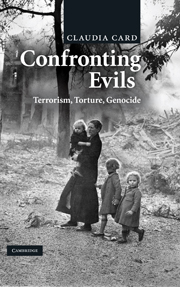If the slave no longer belonged to a community, if he had no social existence outside of his master, then what was he? The initial response in almost all slaveholding societies was to define the slave as a socially dead person. (Patterson 1982, p. 38)
PROLOGUE
Social death is not necessarily genocide. But genocide is social death. Social death has many sources – slavery, banishment, disfigurement, illness, even self-chosen isolation. It can be an evil or not, depending on the harm it does and whether it results from inexcusable wrongs. Self-chosen isolation ordinarily leaves open many possibilities for reconnecting. Even when isolation is not self-chosen, a person who is shunned is not ordinarily cut off from a shared language, history, traditions, and the like. Genocide is an extreme of social death.
The intentional production of social death in a people or community is the central evil of genocide. That is so not only when a genocide is mainly cultural but even when it is homicidal on a massive scale. Social death distinguishes the evil of genocide, morally, from the evils of other mass murders. Even genocidal murder can be understood as an extreme means to the primary goal of social death. Social vitality exists through relationships, contemporary and intergenerational, that create contexts and identities that give meaning and shape to our lives. Some of those relationships are with kin, friends, and coworkers. Others are less personal and mediated by basic social institutions – economic, political, religious, educational, and so on.
